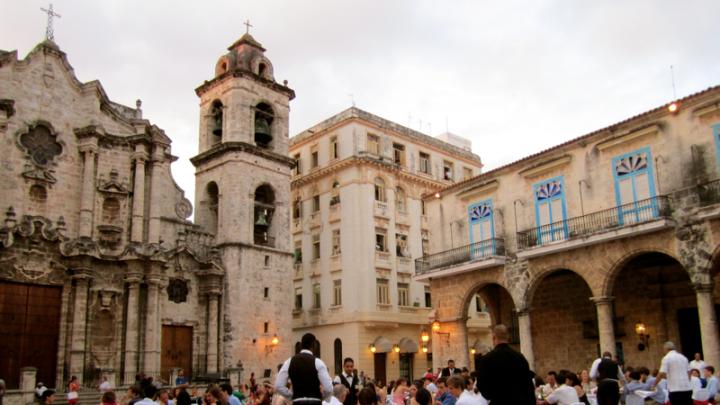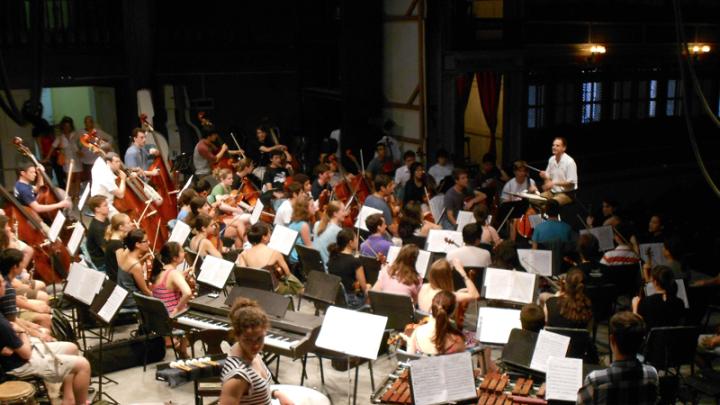I suppose we didn’t really know what to expect. At least, I didn’t. All I knew was, I was a bit nervous. It was 3:58 in the morning on May 27, and I, along with 85 of my closest friends from the Harvard-Radcliffe Orchestra (HRO), was on a bus to Logan International Airport. HRO had received a license from the U.S. government to embark on a one-week, three-concert tour of Cuba, making us the first American orchestra to travel there since 1959. While I might not have known what to expect of Cuba, our expectations for the tour and of ourselves were rightfully high.
We flew from Boston to Miami, and from Miami to tiny Jaime González Airport in the coastal city of Cienfuegos. It was surreal to be standing in the land of forbidden C’s: Communism, Castros, and Cuban cigars. On the bus ride to Hotel Jagua, I tried to absorb it all as our tour guide, Jorge (all Cuban names have been changed), explained to us how the dual currencies worked, and why we shouldn’t buy cigars on the street. “They’re not real,” he told us.
We had come here to play music. But why Cuba? The United States had abandoned all formal diplomatic ties with the country. In any case, orchestra tours often occur in countries like Germany or Italy, places with strong traditions of classical music, places that make sense. If orchestras do tour Latin America, they usually make a stop in Venezuela, with its famous state-wide youth orchestra program. In Cuba, however, you’re more likely to find claves than classical music; you’re also more likely to find just about anything other than a group of 80 Americans. But that was the point. Cuba might not be known for its Mozart, but it is known for its music. Maybe music, no matter the genre, could be the diplomat that the two countries had lacked since 1959.
The Teatro Tomás Terry in Cienfuegos, where our first concert took place, is beautiful; like most buildings in Cuba, it isn’t particularly big, or exactly new (a Cuban-American friend once told me that going to Cuba “is the only way to time travel”). But the high ceilings, opera-house-like boxes, and intricately decorated wood made it a unique venue. There we met the two professional Cuban percussionists we had recruited to help us with our encore piece, Cuban Overture, by George Gershwin (or, as they called it, “el Hare-SHWEEN”). Roberto would be playing the bongos, Carlota, the timpani, and I, the guiro (a notched gourd that is played by rubbing a wooden stick along the side). We introduced ourselves in Spanglish as we hurriedly set up for rehearsal. (“Hablo un poco de español,” I told them. I took it for six years before college.)
I was interested to notice that Carlota had arranged the timpani in the German style, with the highest drum on the left side. When I told her that there wouldn’t be much time to change the order of the drums after I finished playing timpani on Dvorak’s Ninth Symphony, From The New World, she graciously accommodated my request to rearrange them from low to high, as I was used to. Later, when we rehearsed the fourth movement of the Dvorak, I was surprised to hear Carlota whistling along.
Roberto, Carlota, and I decided to get dinner before the concert began. We were joined by their music director, Tomasina, and the arts administrator coordinating the concert, José. He ordered us ham sandwiches, with potato chips and drinks to tide us over.
It was a wonderful meal. It wasn’t so much the food—Cuban ham sandwiches are about as exciting as American ham sandwiches, and in any case, Cuban restaurants aren’t exactly Jean Georges. But I so enjoyed my conversation with my fellow musicians. They spoke in slow Spanish to accommodate my rustiness. In Cuba, they told me, students who want to become musicians go to music schools in their early teens. Few go to university to continue studying afterward. Carlota was taking university courses part-time, but she and Roberto, both in their early twenties, were quite young to be professional orchestral musicians by American standards. They played Cuban music in their orchestra, Tomasina explained to me, but also much of the “traditional” orchestral literature. Now, Carlota’s whistling of the Dvorak made sense. Both she and Roberto supplemented their incomes—about $15 a month—with gigs playing drums in more traditional Cuban bands.
This became evident when, after a discussion of our astrological signs, a band happened to enter the restaurant, and José pretended it was my birthday so the band members would sing to me. They offered Carlota and Roberto a pair of claves, which they happily took, easily settling into a salsa rhythm. All four of my dinner companions joined in singing for my “birthday,” and the band stuck around for several numbers before our food came. I paid for the meal, which was in the tourists’ currency. It cost $22 for the five of us.
I didn’t know how many Cubans would come to a classical music concert in Cienfuegos. I was pleasantly surprised—the un-air-conditioned concert hall was full of local residents beating paper fans. We performed Tchaikovsky’s Piano Concerto No. 1, featuring Damon Meng ’13, the Dvorak, and the Hare-SHWEEN. Our performance went well—despite the, er, evidence of bats that appeared on the timpani during the fourth movement of the Dvorak, a relic of the stage’s high ceiling and outdated construction. The audience graciously put down their fans to give us a standing ovation. Their applause ended in unison, in what one friend later said is called the “Communist clap.” Afterward, the entire orchestra celebrated with a reception full of salsa dancing and Cuba libres. Carlota and Roberto tried to teach me how to salsa, to little avail. They were excellent teachers; I was a poor student.
Our next concert, at the Teatro La Caridad in Santa Clara, was a collaboration with Carlota, Roberto, and Tomasina’s Orquesta Sinfónica de Santa Clara, which I was eager to hear. I was not disappointed. The small orchestra had many young players, around the same age as those in HRO. They opened the performance by playing what Americans might consider typical classical music, but I was most interested in their Cuban pieces, which featured more percussion than the standard European work. Carlota played an incredible solo on the bongos, and Tomasina called her to the front of the stage at the end of the performance. The audience, once again filling the hall, wasn’t jaded by the music either; they even applauded during some of the orchestra’s pieces. In the United States, it is taboo to clap in the pauses between the movements of a piece, much less while the orchestra is playing. (In my experience, those pauses seem to exist to allow audience members to cough up the hairballs that have apparently accumulated in their throats during the previous movement.) HRO’s performance after the intermission wasn’t too shabby, either, and it was fun once again to collaborate with Carlota and Roberto on the Cuban Overture.
Cienfuegos and Santa Clara were wonderful, but I was most excited to visit Havana. It is the center of all things Cuban—the best jazz and salsa venues, the most classic-looking cars, the most luxurious ambassadors’ mansions, the most famous of cigars. Thus, it was only fitting that Havana was where our most significant musical endeavor would take place: a performance of Beethoven’s Symphony No. 9, one of the workhorses of the symphonic literature. We collaborated with the Coro Nacional de Cuba, the Coro de Ópera de la Calle, and soloists from the Instituto Superior de Arte for a concert at the Gran Teatro de La Habana.
American classical music is plagued by a lack of racial diversity. The Cuban choruses, however, seemed to reflect accurately the racial make-up of their country, with singers who were black, white, brown, and everything in between. It was refreshing to see that classical music didn’t predict the racial composition of the musicians as much as it did in our country. One of my friends on the trip wondered if there is less racism in Cuba, because communism places everyone on more or less equal economic ground. It is a bold claim: is economic equality a necessary prerequisite for full racial equality? In the United States, the socioeconomic status and racial background of one’s parents still, to a devastating extent, predict one’s future economic outcomes. I wondered whether Cuba—if it ever adopted a capitalist economy, in which everyone started at the same wage level of $10 or $20 a month—would be a perfect meritocracy.
As a timpanist, I always love playing with choruses. I’m right in front of the action. The Cuban choirs were no exception; their singing of Beethoven’s famous “Ode to Joy” gave me chills. We were musicians most comfortable in English and Spanish, yet here we were, playing music sung in German, which I suppose became the best way we knew how to communicate. It was, in a word, awesome. (That is the technical, musical term.)
HRO members have pointed out the significance of Beethoven 9, played in a country normally forbidden to us. It is a piece about brotherhood, and performing this symphony with Cuban singers in Havana was a tribute to this theme and a significant moment in the history of the piece.
But Beethoven’s Ninth is also a piece about joy. And joyful we were.
Elizabeth Bloom ’12 of Currier House is a Crimson staff writer. This summer, she is interning at CNN in New York City.











